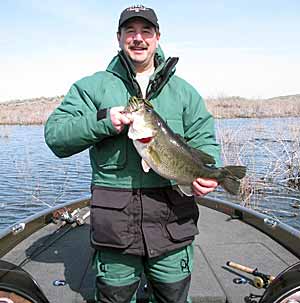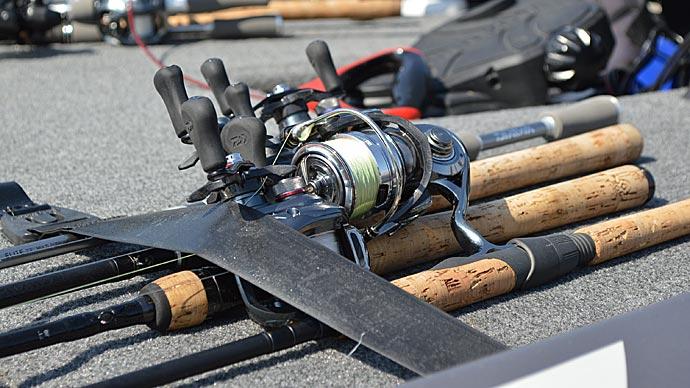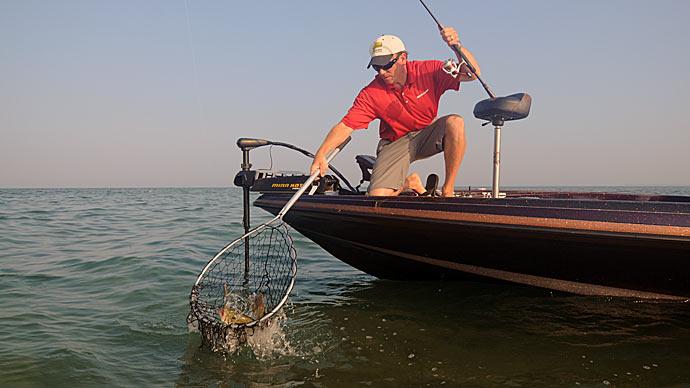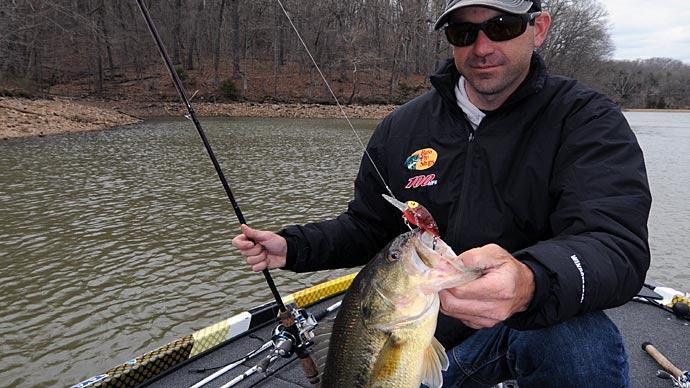
Whether you are experienced, a novice or even a tournament contender, one of the essential factors in bass fishing is using the right equipment for your baits and tactics. This is very important because you can overwork your baits, thus causing the fish not to strike. Overworking a bait can be a contagious disease, especially for a male angler (okay ladies! this one's for you...) because a woman has more patience at working baits than a man (sorry guys, but it's a proven fact.). I have noticed this many times from the husbands with their wives, girlfriends/boyfriends, brothers/sisters, and even the male/female "tournament team" anglers.
Overworking a bait can be caused by several different reasons. Probably the biggest reason is using the wrong retrieve speeds with your reel. For example, let's take a crankbait; a crankbait is designed to work a certain way at various speeds. That's one of the reasons why they manufacture crankbaits with different shapes and sizes.
For instance, a crankbait with a narrow body is designed to work much faster than one made with a fat body, which is usually designed to work at a much slower speed. Now, if your reel has a 6:2 retrieve speed, your reel would cause the crankbait to work way too fast at an average wind. On the other side of the coin, if you had a 5:1 or a 4:3 retrieve speed, a normal retrieve would allow the crankbait to work correctly. That said, you should experiment with your speeds and let the fish dictate how they want the bait on any given day.
Let's talk about reels for a moment. Baitcasting, spinning, and spin-cast (or closed-faced) reels can be considered tools of the trade. A personal preference from each individual will pretty much decide what type of reel one would use for their comfort. I use all three of the different reels for different applications when I fish. Daily conditions, the size and weight of the bait, and the areas to be fished will always tell me which type of reel I would use under different circumstances.
Let's say that we are facing into the wind (always for the best boat control), and we are fishing around and under docks with a light bait, and we have to cast into the wind, which reel should we use? If I used a baitcaster and it is windy, well, I don't think I would cast a little bait into the wind because of getting that "professional override" (or BACKLASH! Oohh, that's such a nasty word).
What about using a spinning reel? Some anglers may use one for this type of casting, but every time I cast a little bait into the wind with a spinning reel, I usually wind up with that darn ole line twist. So, what is the best application to use for this scenario? A spin-cast Reel! Now stop and think about it for a moment; all you have to do is push the button on the reel and make your cast into the wind. The line freely unwinds off the reel with no tangles allowing you to put your bait where you make your cast.
There are many different types of bait, presentations, and techniques used today in the sport of bass fishing, and the reel selection mainly depends on what is the most comfortable for the angler. Now, please don't take this the wrong way because I will not say that you have to use a specific reel for specific applications, but I will tell you what works the best for me.
I use a baitcasting reel about eighty percent of the time because I feel that I have much more control at casting and hook setting and comfort than the others mentioned. I like the thumb control on the spool with a baitcasting reel because it allows me to stop the bait on a dime when it comes to accuracy. I also like the power in the retrieve, especially when it comes to hauling big bass out of vegetation and different structured areas. However, I like the spinning reel for vertical fishing and making casts with lighter baits. Here are the reel applications I mostly use for the following:
Flipping and pitching - Baitcaster
Texas-rigged plastics - Baitcaster or spinning
Carolina rigs - Baitcaster
Crankbaits - Baitcaster or spinning
Topwater - Baitcaster
Spinnerbaits - Baitcaster
Soft jerk baits - Baitcaster or spinning
Drop shot - Spinning
Next, let's talk about rods. Using the proper length, strength, and action of a rod is extremely important for fishing various types of artificial baits. This is why rod manufacturing companies make so many rods in so many different sizes, lengths, and strengths. For example, if I were to fish a crankbait, I would use a softer tip rod with a medium or lighter action. Using this type of application will allow me to catch more fish than using a stiffer action rod. The reason is that most of the crankbaits manufactured are made with treble hooks, and if you were to look at the treble hooks versus the single wide-gap worm hooks, you would see that the points of a treble hook are very close together, and the shank of the hooks are very short. If you use a strong hook set with these types of hooks, you would more than likely pull it right out of the bass's mouth. You don't get the penetration into the bass like a single worm hook. So, using a soft tip rod bends (or flexes) to where you won't have a sudden stop as if using a stiff rod. And a steady pressure while retrieving the bass back to the boat will usually land the fish.
The lengths of fishing rods can also be a key factor while fishing different types of baits. If you were to fish a Carolina rig, a longer rod would be more helpful than a shorter one. Because of the sweeping action, one needs to pick up slack quickly to keep pressure on the fish.
A longer rod is also helpful when flipping and pitching like a jig-and-pig combo or the new Creature Bait (made by Gary Yamamoto's Custom Baits) because one would get more distance fishing pockets or pitching for distance. On the other hand, a shorter length rod would be helpful if an angler was fishing around fall-downs, dock areas, and close-structured areas. Again, rods' lengths can be one's preference with the various bait applications, but the ones mentioned seem to work the best for me.
Next, believe it or not, the weight of a rod can be a tremendous help for an angler that fishes all day long. In the past years, I have had several different rod sponsorships with companies that make quality rods, and it seems that each rod with the same size and action from each of the different companies would be of different weight. The weight of a rod can make a big difference when you spend a whole day on the water, literally making hundreds of casts or pitches. I have often thought my arms were about to fall off from casting so much.
These are just a few of the applications that seem to work the best for me after years of trial, frustration, and countless hours of experimenting. I hope this article can help you better understand equipment and bait applications.




